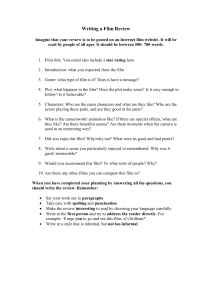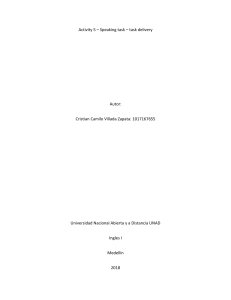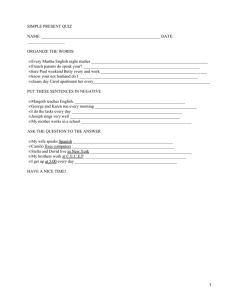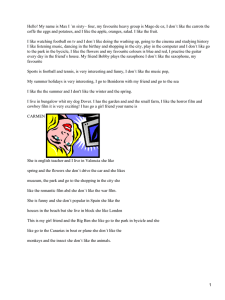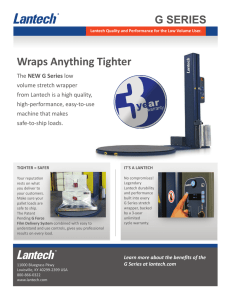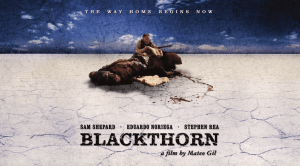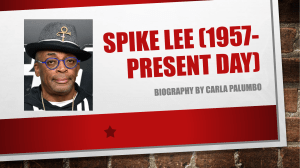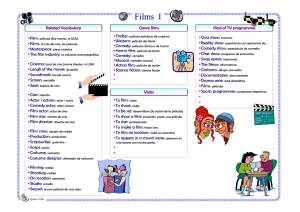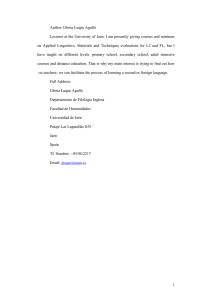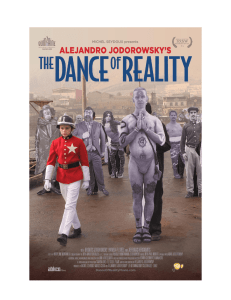impression of a war - Camilo Restrepo Films
Anuncio
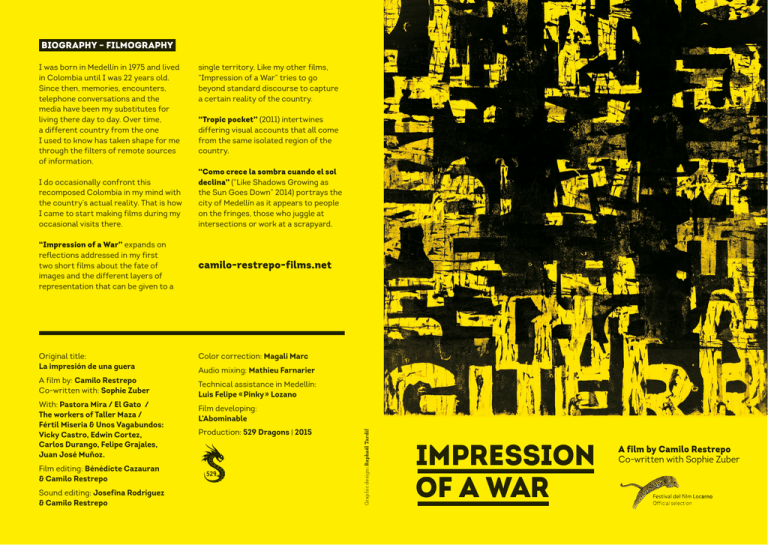
BIOGRAPHY – FILMOGRAPHY I do occasionally confront this recomposed Colombia in my mind with the country’s actual reality. That is how I came to start making films during my occasional visits there. “Impression of a War” expands on reflections addressed in my first two short films about the fate of images and the different layers of representation that can be given to a Original title: La impresión de una guera A film by: Camilo Restrepo Co-written with: Sophie Zuber With: Pastora Mira / El Gato / The workers of Taller Maza / Fértil Miseria & Unos Vagabundos: Vicky Castro, Edwin Cortez, Carlos Durango, Felipe Grajales, Juan José Muñoz. Film editing: Bénédicte Cazauran & Camilo Restrepo Sound editing: Josefina Rodríguez & Camilo Restrepo single territory. Like my other films, “Impression of a War” tries to go beyond standard discourse to capture a certain reality of the country. “Tropic pocket” (2011) intertwines differing visual accounts that all come from the same isolated region of the country. “Como crece la sombra cuando el sol declina” (“Like Shadows Growing as the Sun Goes Down” 2014) portrays the city of Medellín as it appears to people on the fringes, those who juggle at intersections or work at a scrapyard. camilo-restrepo-films.net Color correction: Magali Marc Audio mixing: Mathieu Farnarier Technical assistance in Medellín: Luis Felipe « Pinky » Lozano Film developing: L’Abominable Production: 529 Dragons | 2015 Graphic design: Raphaël Tardif I was born in Medellín in 1975 and lived in Colombia until I was 22 years old. Since then, memories, encounters, telephone conversations and the media have been my substitutes for living there day to day. Over time, a different country from the one I used to know has taken shape for me through the filters of remote sources of information. IMPRESSION OF A WAR A film by Camilo Restrepo Co-written with Sophie Zuber IMPRESSION OF A WAR CONTEXT For over 70 years, Colombia has been confronted with internal armed conflict. Over the years, the outlines of the conflict have grown indistinct. Complicated ties have been woven between the various players: guerrilla groups, drug traffickers, military and paramilitary forces, and mafia-style gangs. The entire country has been turned into a battlefield, leading to a climate of generalized violence settling gradually over the entire society. DIRECTOR’S STATEMENT Over the course of the investigations and archival research I carried out for this film, I was confronted with the problem of presenting the Colombian conflict according to a structure or theme that would provide order for the events and context for the personal accounts. Yet every attempt at creating at outline or specific standpoint seemed to me to represent an oversimplification of the problem. We, the people of Colombia, probably haven’t achieved enough detachment yet to be the ones to analyze a situation that is still assaulting us. The war in Colombia is not over yet, and the violence, even less so. I belong to a generation of Colombians who were strongly affected by the most violent years of the conflict and who bear the stigmata of the war. All that we can bring to this first stage of analyzing our recent history is our own stories, our own impressions. My goal was to capture visible traces of the violence in the daily lives of the people who live in that country. Images from the battlefields, memorial images, images inscribed in the urban landscape, intimate representations of experiences people have lived through… These traces – deliberate, accidental, ostensible, fleeting or dissimulated – constitute the raw material for “Impression of a War”. To connect these images, while paying attention both to the conditions in which they emerged and to their fate as images, the film proposes a reflection on composing memories of the Colombian conflict. 16 MM My decision to work on physical film is not rooted in nostalgia for a medium that is slowly disappearing, but on the conviction that images draw their meaning from the plurality of media in which they take shape. The materiality of the image is at the heart of my work as a filmmaker. I shoot and develop in an AV lab belonging to “L’Abominable”, a filmmakers’ collective. I create the image mentally as I am manipulating it physically, and my films evolve constantly in response to technical decisions. My training as a painter clearly influences how I work as a filmmaker, and the choice of subjects I address in my films. Choosing this medium and the technical constraints that it implies does in fact have a direct resonance with the film’s propos.

